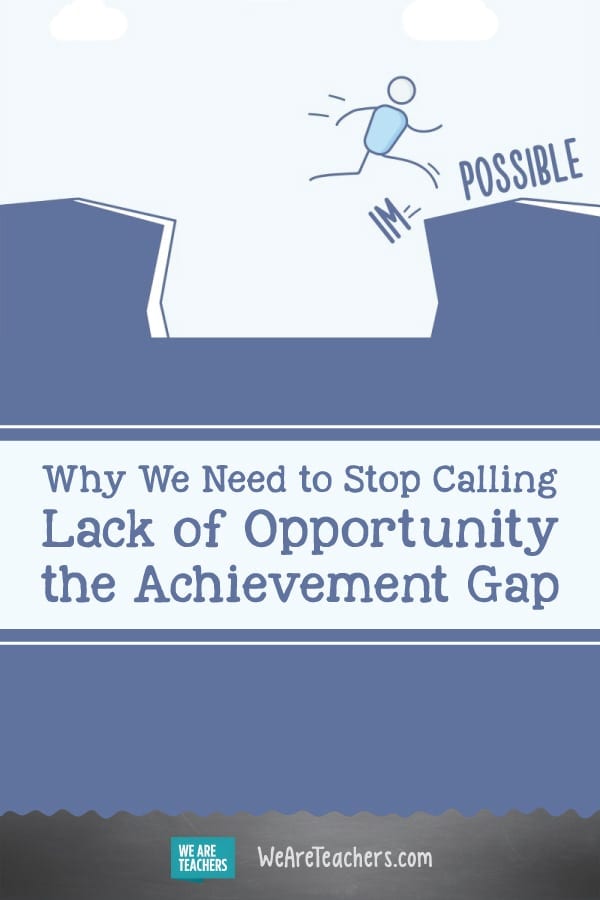I became a career teacher under an interesting set of circumstances. A private school recruited me to teach and revive their speech program because of my experience in forensics (speech and debate). I was not ready for what teaching would do to—and with—my heart. In the middle of my first day, I realized that I wanted to do this work for a long time. And I also realized that I wanted to move out of the private sector and into public education. So I left the private school for a low-income, Title I public school. Suddenly, because the population of students was no longer affluent and privileged, I kept hearing about the achievement gap. The phrase made its way into nearly every district training and faculty meeting I attended.
I’d heard so much about the achievement gap in education, and I wanted to do something about it. However it didn’t take me long to see that this so-called achievement gap in education doesn’t actually exist. The phrase, it seemed to me, was reserved for low-income, black students. And it didn’t really accurately describe what was going on inside the schools that serve them.
This is more of a race issue than many want to admit.
The achievement gap in education is defined as “the disparity in academic performance between groups of students.” The comparison of grades, standardized test scores, course selection, dropout rates, and college-completion rates, among other success measures, is considered evidence of this gap. While the phrase, by definition, seems universally applicable to all students, that really doesn’t happen. The discussion of the achievement gap is, ordinarily, reserved mostly for Hispanic students, black students, and students from low-income backgrounds. Frankly, it is a phrase to describe why those students aren’t doing as well academically as white students.
The achievement gap does not account for the vexing ways both historical and contemporary systemic factors, such as racial and economic segregation and the underfunding of public schools, has impacted the kind of education students who have less privilege often receive. In other words, “achievement gap” vernacular refuses to consider America’s unsavory and intentional historical choices to keep black people, in particular, behind whites in every way.
The achievement gap has sadly become the latest euphemism for a longstanding set of beliefs about black students. You’ve probably heard some of them before. “Those kids don’t want to learn.” Or, “Those kids don’t care about school.” The idea of an achievement gap also misleads well-meaning, good-intentioned people into believing that the disparity exists because black students are less curious and less driven academically than white students and thus need to be saved or inspired to achieve in school.
Standardized testing is no way to label kids.
We also need to understand that the achievement gap is identified and measured by an imperfect instrument. Since the 1960s, the only comprehensive method to define the gap itself has been standardized testing. In other words, the only way to actually see the gap is by comparing the test scores of students of color to that of white students.
We know that standardized testing is not the be-all and end-all for measurements or assessments of learning. We know that kids are more than data. Yet, many of us regard the achievement gap as valid even though we know the limits of standardized assessment, the instrument that measures it.
Now, don’t get me wrong. Data is helpful and useful to drive instruction, it really is. But when used as wide sweeping evaluation of an entire group of kids? Not so much. So, we cannot automatically trust the idea of an achievement gap. After all, we know that students are far more than their standardized test scores. Do you trust one test to evaluate your students’ entire year of learning? Probably not. So we shouldn’t trust it to determine whether or why some students don’t “achieve” as much as others.
The opportunity gap is what we should be talking about.
Black and Hispanic children are just as bright and academically capable as white students. Racial identity does not influence whether someone wants to learn. There isn’t some innate difference in the academic prowess of students based on their race or socioeconomic background. But there are structural inequalities certain groups of students, namely black students, Hispanic students, and students from low-income backgrounds, face. In other words, there is no achievement gap. There is, however, an opportunity gap.
Believe it or not, all students do not have the same opportunities. In his book We Were Eight Years in Power, writer Ta-Nehisi Coates cites an NYU study which described research conducted on the backgrounds of kids born between 1955 and 1970. The study found that “4 percent of white children and 62 percent of black children across America had been raised in poor neighborhoods.” That’s staggering. Researchers conducted the same study in 2017 and found that nearly nothing had changed. Why is this information important? It’s important because children living in poverty do not always have access to the opportunities, like the chance to attend well-resourced schools, that wealthier children do. It also means that those children might be dealing with issues, such as food insecurity, that negatively impact their school performance. There is just one of many reasons for the gap.
Certain public policies, like affirmative action (whatever your opinion of it), highlight and attempt to address the pervasive structural inequalities that minority and economically marginalized groups face. In other words, these policies are evidence that these students lack opportunity. And this lack of opportunity does not magically appear the moment a student of color graduates from high school. It exists from the beginning.
Let’s open up a lot more opportunities.
I think that the original intention behind defining, measuring, and using the achievement gap was good. It is never a bad thing to attempt to close gaps in student learning. If anything, the term “achievement gap” is inaccurate and outdated. As Shani Jackson Dowell, the executive director at Undergraduate Pathway puts it, “Something about those two words feels as outdated as the term ‘Negro.’ So, just as we stopped calling Black people ‘Negroes’ many years ago, I believe it’s time to find words that more accurately reflect our ever-diversifying and increasingly complex society.”
I propose that we no longer attempt to close the achievement gap. Instead, we must redirect our efforts and aim our targets at the opportunity gap. We don’t define the opportunity gap by looking at test scores. Instead, the opportunity gap more accurately describes the complex issues that contribute to student performance. Recognizing the opportunity gap changes the way we communicate, the way we think, and the way we teach. It forces us to recognize the historical and societal implications of the way race and class influence the kind of education a student is likely to receive. Once I shifted my focus from the achievement gap to the opportunity gap, I stopped telling my black students to pull themselves up by their bootstraps. It meant that I rededicated myself to helping my students advance themselves despite hardship and lack of resources.
When you recognize that some students in your class start much farther behind the starting line than their white peers, your thoughts, your words, your actions, and maybe even your heart will change.
What are your thoughts on the idea of the achievement gap? Come and share in our WeAreTeachers HELPLINE groupon Facebook.


